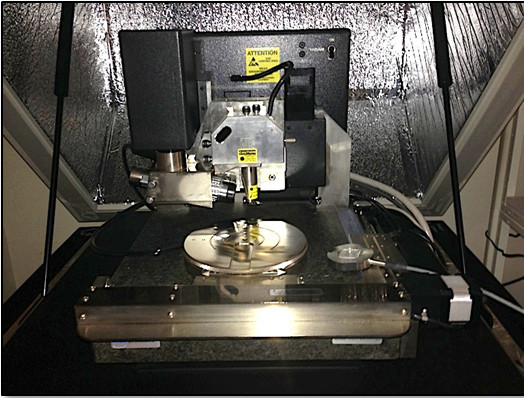AFM Dimension 3100 (Bruker)

Device description:
The AFM (Dimension 3100, Bruker), allows to map the topography of a sample surface, together with some of its physical and/or mechanical properties, with fields of view ranging from 90 µm to a few tenths of nanometers.
Several modes are available: tapping, contact, EFM and MFM.
Accessories: cell for experiments in liquid, backlit sample holder for thin layer of standard thickness, vibration-free box.
Principle:
Atomic force microscopes consist of a sharp tip fixed under a micron-sized cantilever; the instrument works by measuring the deflection of the cantilever as it scans across the surface of a the specimen, not only resulting in maps of surface topography, but also giving insight into some of its physical and mechanical properties.
-
Contact Mode. The tip stays in contact with the sample when scanning, the vertical deflection is kept constant so that the z displacement of the cantilever provides a direct image of the topography of the sample surface (whereas the horizontal deflection gives insight on friction force between the tip and the sample). This mode also allows to perform punctual approach-retract curves, providing local characterizations of sample mechanical properties (inelastic and elastic deformations, adhesion force between the tip and the surface, etc…). Its main drawback lies in the fast degradation of fragile samples and tips, and the resulting artifacts.
-
Tapping Mode. The tip is oscillating at the cantilever’s resonance frequency, and the contact with the surface is only intermittent. The surface topography is therefore imaged with minimal damages. Furthermore, the phase-lag (error signal) provides images, the contrast of which can be interpreted as a variation of surface viscoelasticity.
-
MFM Mode. The magnetized tip is oscillating at the cantilever’s resonance frequency and scans at a fixed altitude (non-contact mode) the surface of a magnetic sample. The frequencies modulations caused by the surface/tip magnetic interactions allow to map local magnetic fields variations.
Lateral resolution: depends on the nature of the sample and type/curve radius of the tip.
Contacts:
Julius NOUET – 01 69 15 61 21 – This email address is being protected from spambots. You need JavaScript enabled to view it. (responsable scientifique et technique)


